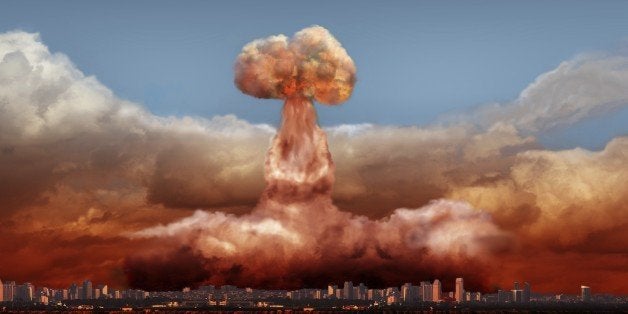
As some of you may know, Ayn Rand, like many famous novelists, had a period when she "went Hollywood." True, she was no Faulkner or Fitzgerald, but in 1943, Rand sold the rights for The Fountainhead to Warner Brothers, and wrote the screenplay. She was then hired by top producer Hall Wallis.
Her screenplays included the Oscar-nominated Love Letters and You Came Along. After the war she joined the anti-Communist movement in Hollywood and appeared as a friendly witness before Congress in testifying about the Red influence there.
At the same time she also had a love affair -- with the atomic bomb, which had just been used twice against Japan, killing over 200,000, mainly women and children.
I learned this in my research at the Truman Library concerning an MGM movie titled The Beginning or The End. This was the first Hollywood epic about the Bomb. The idea for the film came from atomic scientists and the first scripts raised questions about the use of the new weapon against Japan and all uses of nuclear energy in the future. By the time the Pentagon and the White House got through with it, the movie took a 180-degree turn. President Truman even got the actor playing him in the movie fired.
But there's also a fascinating sidebar: While the MGM film was being planned in late 1945 and early 1946, a second film was being developed by Hal Wallis -- and Ayn Rand wrote the script.
This film was to be titled Top Secret. The Hollywood trades compared the race to make the first atomic film to the U.S. vs. Germany race to make The Bomb. At the Truman Library, I discovered a 16-page outline by Rand from January 19, 1946. We follow the lead character, named John, during the rise of Hitler, early work on the physics of the Bomb abroad, his service in the Army and then his assignment -- to guard J. Robert Oppenheimer, the so-called Father of the Bomb, at Los Alamos. Much like the key scene in The Beginning or the End (which the White House rewrote), it shows Truman deciding to use the bomb against Japan as a last resort and strictly "to save American lives."
Oppenheimer, after Hiroshima, tells John at Los Alamos that "the achievement was not an accident -- only free men in voluntary co-operation could have done it -- so long as they're free, men do not have to fear those who preach slavery and violence." It ends with a classic Randism, "Man can harness the universe -- but nobody can harness man!" It does raise dark warnings about future threat, showing a clock ticking and the claim, "It's later than you think!"
But a month later, a 65-page section of a script (obviously sent to the White House for approval) has merged The Beginning or the End and Top Secret and included some of Rand's writings. MGM had made a deal with Wallis to make sure there was no rival project. Variety reported on March 20, 1946, that in a deal "without precedent" Wallis transferred all his materials, including Rand's work, to MGM, for share of the gross.
How did this all start? From Rand's own papers and journals, we learn that when she accepted the assignment from Wallis she said she'd only do it if she could express her own political and philosophical views, which might clash with the studio's. She then interviewed many of the leading figures in the Bomb's development, including Oppenheimer.
Many years later she revealed that the character Robert Stadler in Atlas Shrugged was based on Oppenheimer. The papers also show that after MGM bought out Wallis, Rand was then free to work full-time on Atlas Shrugged.
She also wrote for Wallis an amazing and quite lengthy memo, An Analysis of the Proper Approach to a Picture on the Atomic Bomb.
Rand's memo opens with the astounding claim that it was not the bomb itself, a mere "inanimate" object, but a bad movie about it that could turn out to be the "greatest moral crime in the history of civilization." After all, whether the Bomb is used again depends on the "thinking of men," and movies were now the most influential elements in all of society. So she aimed for an "immortal achievement" that would prevent the result of "millions of charred bodies -- those of our children."
The real danger was posed by the world's decline into "Statism" at the expense of "free enterprise." And "Statism leads to war." Now, with the atomic bomb in the world and Statism on the march our days were literally numbered -- unless the "trend" to Statism was "reversed." Because: "An atomic bomb is safe only in a free society."
But does that mean Rand hated the Bomb? Hardly. In fact, she extols its creation as "an eloquent example of, argument for and tribute to free enterprise." As evidence she cites the fact that despite its massive state power, Germany could not create the weapon but the United States did.
But doesn't the United States have its own form of Statism? "Our government seems to have acted properly in regard to the atomic bomb," but don't give the White House and Washington too much credit -- it was the individual scientists who pulled it off, as if with the help of God. In fact, she argued, the film "must show clearly" that it was the scientists and the military who ran the bomb project, "not the government." And it was the industrialists who supplied the materials. If the film showed President Roosevelt in a "favorable" light, it must do the same for DuPont.
If the studio followed her script, "the general tone of our picture will be that of a tribute to America -- an epic of the American spirit."
Greg Mitchell tells the full story of the film in his ebook Hollywood Bomb.
